| Roger Reini's Bahá'í Pilgrimage Journal | ||
| First Attempt Prelude to Departure Departure for the Holy Land Day 1 Day 2 Day 3 Day 4 Day 5 Day 6 Day 7 Day 8 Day 9 Return Home Pilgrimage Home Page |
Day 3 December 26, 2007 I made sure to partake well at the breakfast buffet today, eating buckwheat cereal, several cheeses, scrambled eggs, a croissant, and a peach. Then came a taxi ride to the PRC by the same driver who took me yesterday morning. It was well before our time of departure, so I sat with Nicole Kelly and (eventually) her family. As we boarded the bus to ‘Akká, I readied my camera. Today it was appropriate to take pictures along the way. As we went through the streets, Furio pointed out the location of the future House of Worship to be built on Mount Carmel. From our bus, we could see the top of the obelisk marking the spot. I wanted to take a picture but could not; I was on the wrong side of the bus for that. It turned out I could see the obelisk and temple land from my hotel room, courtesy of the zoom lens on my camera. Furio also asked me to read a prayer at the Prison Cell of Bahá’u’lláh. I had recited a prayer at our group briefing yesterday, and he was impressed enough to entrust me with this bounty and honor. When we arrived in ‘Akká (that’s how it’s known to the Arabs; Israelis call it Akko, in English it’s Acre), our first stop was the Citadel that served as Bahá’u’lláh’s prison. For the first two years He was in ‘Akká, He was confined to a room in the citadel (then used as barracks by the Turkish army). As Furio briefed us before we entered, a cat that looked like Murdock (a tuxedo cat, now deceased, once owned by my aunt & uncle) came by and seemingly stood guard over us. We proceeded to the north wall, where we saw the spot where pilgrims denied the bounty of meeting (or, to use the preferred term, attaining the presence of) the Blessed Beauty had to stand in hope of a wave from His hand. We saw the windows from where He would wave (this was not His cell; that was on the other side). I could not help but think of the story of ‘Abdu’r-Rahim (his great-grandson, Ramin, used to live in Westland), how he went to that spot but, instead of a wave, received a beckoning to come inside. 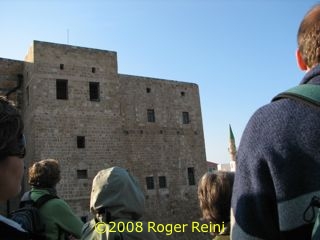 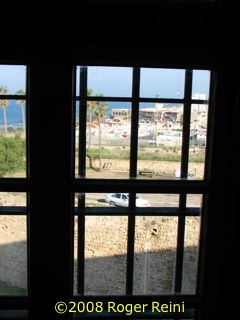 We then entered the prison proper, then went up a flight of external stairs to the rooms where the Holy Family was kept. As we entered, the first thing I noticed was the roped-off area, man-sized. Knowing its significance, I immediately looked up. Yes, there was the skylight. I’m sure everyone there knew the significance of that spot. It was there that Mirza Mihdi, the Purest Branch, younger son of Bahá’u’lláh by His first wife, fell from the roof while enraptured in prayer. While pacing the roof, he forgot where he was and fell through the skylight, landing some 20 feet below on some wooden crates. Ribs broken, lung pierced, he lay mortally injured. His mother heard the crash and came running to find him lying in a pool of blood. Bahá’u’lláh was summoned, and He offered to heal His son’s injuries. But he said to let him pass on, to let him give up his life so that the pilgrims would be able to attain His presence again. This sacrifice was accepted, and we heard the verses that He revealed on this occasion. I am sure I was not the only one there with tears in his eyes. We then saw the north-facing rooms that we had seen from the outside, and then we entered the Most Great Prison Cell. 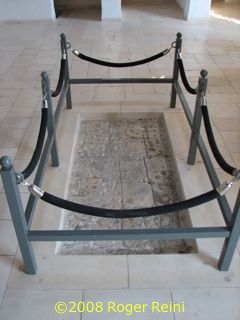 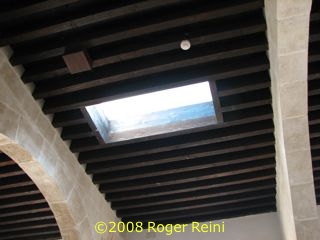 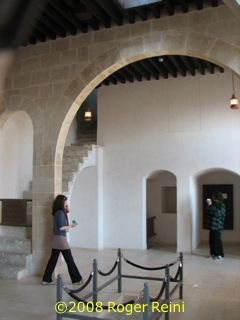 The citadel was owned by the Israeli government, but the Universal House of Justice owns the only key to Bahá’u’lláh’s cell. The room was about the size of my bedroom (which happens to be a decent-sized bedroom). Two windows with horizontal bars faced the sea; the view encompassed the home of Abdullah Pasha as well as the sea; no greenery could be seen. It was here that I recited the prayer I had been asked to read. O my God! Thou beholdest the Lord of all mankind confined in His Most Great Prison, calling aloud Thy Name, gazing upon Thy face, proclaiming that which hath enraptured the denizens of Thy kingdoms of revelation and of creation. O my God! I behold Mine own Self captive in the hands of Thy servants, yet the light of Thy sovereignty and the revelations of Thine invincible power shine resplendent from His face, enabling all to know of a certainty that Thou art God, and that there is none other God but Thee. Neither can the power of the powerful frustrate Thee, nor the ascendancy of the rulers prevail against Thee. Thou doest whatsoever Thou willest by virtue of Thy sovereignty which encompasseth all created things, and ordainest that which Thou pleasest through the potency of Thy behest which pervadeth the entire creation. I implore Thee by the glory of Thy Manifestation and by the power of Thy might, Thy sovereignty and Thine exaltation to render victorious those who have arisen to serve Thee, who have aided Thy Cause and humbled themselves before the splendour of the light of Thy face. Make them then, O my God, triumphant over Thine enemies and cause them to be steadfast in Thy service, that through them the evidences of Thy dominion may be established throughout Thy realms and the tokens of Thine indomitable power be manifested in Thy lands. Verily Thou art potent to do what Thou willest; no God is there but Thee, the Help in Peril, the Self-Subsisting. (Bahá'u'lláh, from Tablets of Bahá'u'lláh, pp. 233-4) We then spent several moments in prayer and meditation. How long was long enough to spend? It varied. I was not the first to leave, but I was by no means the last. Once I left, I took pictures of the closed doors, as well as views from nearby windows that approximated what He saw. I also took pictures of the other rooms. 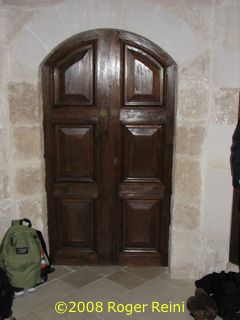 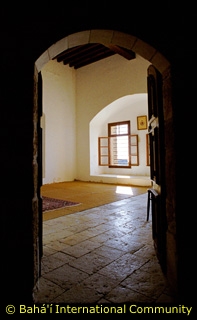 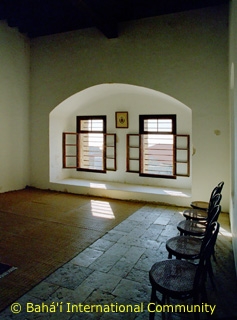 After leaving the prison, we proceeded to the entrance the Blessed Beauty used when He entered the prison. It was close to the Al-Jazzar mosque, still in use today. ‘Abdu’l-Bahá used to worship there. We could visit the mosque on our own (small admission charged). Guide Furio pointed out the domes of the madrassa attached to the mosque; room number 4 was used by the Master when He met with the Quranic scholars. Then we headed back to our bus for the trip around town to the House of Abbúd. Our drive took us through two breaches in the city wall made by the British. The House of Abbúd was actually two houses, the original House of Abbúd and the House of Udi Khammar. Following a 10-month period in which He stayed in three different houses, Bahá’u’lláh took up residence in the House of Udi Khammar, as did the Holy Family. The house was quite undersized for the number of people who lived there; in one room, 13 people had to sleep. But this house was where Bahá’u’lláh revealed the Kitáb-i-Aqdas, the Most Holy Book. We were able to spend some time in that room, to sense His presence, to pray and meditate. 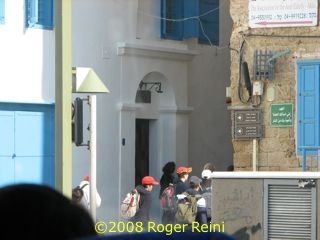 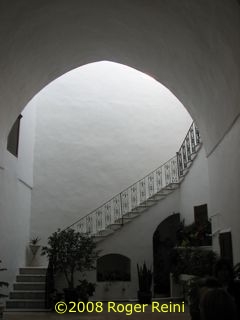 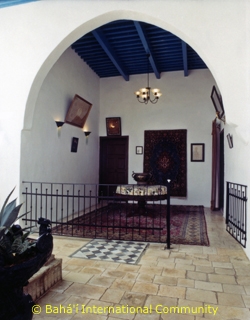 Eventually, the two houses were joined together, allowing the Blessed Beauty to move to a larger room on the sea side of the houses. We were able to see and spend time in His other room. On one side of the room (sea side) was a low couch or divan running the length of the room. His taj was in the left corner; it was covered with a light fabric. In the center of His room were His carpet, His mattress/pillow and His bedding. I visited twice for prayer and contemplation, and between visits, I visited the other rooms, which included the rooms of Navváb and the Greatest Holy Leaf. Throughout the rooms, there were historic memorabilia - maps of various regions of the world dating from the ‘40s (used by the Guardian, presumably), photographs of the House of Worship in Wilmette in varying stages of construction, examples of fine calligraphy, etc. I forgot to mention the tea and cookies we were served by the staff of the house before we paid our visit. But I mention it now, for this marks the continuation of the custom from the early days. Next, we proceeded by bus to the Land Gate, through which Bahá’u’lláh left the city. The gate had a city street running through it, so we had to be very careful to avoid being run over (the sidewalk was narrow). We could see the window from which the Azalís were able to spy on Bahá’ís attempting to enter the city, report them to the authorities. Then we walked to where we could see the Sea Gate, which is where the Holy Family and companions entered the city from the boat from Haifa. It was a hazy day, but I could make out the tall hotels on Mount Carmel. I took pictures but could not see anything in the viewfinder, so I don’t know how well they turned out [some turned out well, others not so well]. 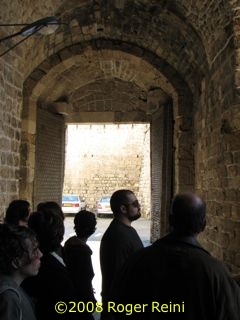 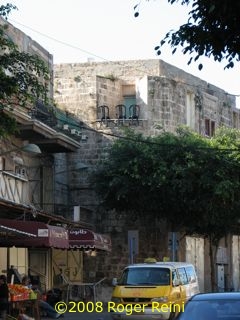 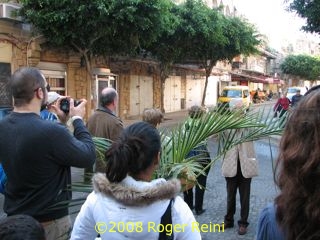 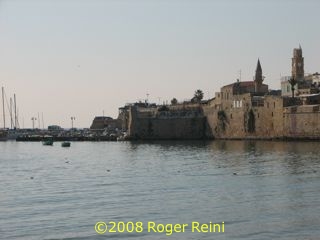 It was time for the bus to return us to Haifa. Some stayed in ‘Akká; some got off at Bahjí when we passed by. As we returned to Haifa, Furio asked me if I would again read a selection when we visited Bahjí tomorrow. I said I would be honored, again. The selection was written by Professor Edward Granville Browne, the only Westerner known to have attained the presence of Bahá’u’lláh. Back at the hotel, I took the opportunity to change memory cards in the camera. It wasn’t full, but it was getting close. Now I had not spent any time exploring the immediate surroundings of my hotel, so I chose to do some of that today. I tried to eat at McDonald’s but could not get served there; youth cut in front of me, barging their way to the counter. So I left. I ran into another pilgrim whose name I have forgotten (she used a cane most of the time) who had just eaten there. It turned out the staff did not speak English very well, which proved a hindrance, she said. Next, I visited a nearby Internet café where I had a Diet Coke and a candy bar while checking e-mail. The rates were better than the hotel (15 shekels for a half-hour, 25 shekels for an hour), AND I could use a full-sized PC and keyboard. The Israeli keyboard had an extra key (backslash) between Shift and Z, which affected my typing. I’d frequently hit backslash when I wanted Shift. I visited a supermarket for some goodies (a package of cookies and a pack of sesame seed bars), and I saw where the stairs were for walking down the mountain. I took those stairs down around 4, while it was still light. I wanted to see where I was going! After one false start, I found stairs that took me down through residential neighborhoods. It took me 20-25 minutes to walk to the PRC. I was carrying my info packet and my pilgrim journal, but I left my camera bag at the hotel to ease the burden on my shoulder. I got some hummus at a local market and brought it back to the PRC for supper. A young boy from Houston, Kian Tavackoli (I had met him and his parents on the terraces Monday) talked for a while. Then I retired upstairs to write in my pilgrim journal. I wrote 6 or 7 pages while I was there. It wasn’t that quiet; there was a group with a guitarist starting to pick out songs. But that was OK. 7 o’clock: time for the reception at the Seat of the International Teaching Center. We walked over in a strung-out group (as opposed to a tightly bunched group) to meet and greet the Counselors who served on the International Teaching Center. Counselor Penny Walker gave the talk on behalf of the Center. Afterwards, while we were waiting to be dismissed to greet the Counselors, some of us (two women in particular) led us in song. One of the women was in my pilgrim group D (I met her husband Andrew later, during the refreshments). Each of us were warmly received by the Counselors, who were all greatly pleased to be hosting us, as was true not only for the Universal House of Justice but also for the whole staff. After the reception, we made our way to the Golomb gate to pick up our sheruts for the ride up Mount Carmel to the hotels. The ride cost 5 shekels, but I paid 10, on behalf of one who hadn’t paid -- I don’t know who. Back in my room, I flipped around the TV channels, noting the Fox News and Sky News coverage of an escaped tiger from the San Francisco Zoo that killed one and injured two others. I recited the passage from E. G. Browne in preparation for tomorrow. Next: Day 4 Back: Day 2 Up: Pilgrimage Home Page DISCLAIMER: this is not an official page of any Bahá'í Institution. All comments are my own and derive from my personal understanding of the Bahá'í Teachings. For official information about the Bahá'í Faith, you may wish to visit www.bahai.org or www.bahai.us. Text ©2008 Roger W. Reini. Photos ©2008 Roger W. Reini except where noted. Photos marked "© Bahá'í International Community" are reproduced with permission of the Bahá'í International Community (http://media.bahai.org/). Written
by Roger Reini |
|